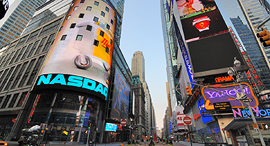Interview
Nasdaq saw 10 times the IPOs it expected in 2020, says stock exchange president
Nelson Griggs, the president of the Nasdaq stock exchange, expected the number of IPOs would drop due to Covid-19 and prides himself instead of over 100 companies listing on the exchange since the beginning of January with an average return of 50%-60%
Over 100 companies completed their IPOs on Nasdaq since the beginning of 2020, raising nearly $30 billion. A strong IPO market normally goes hand in hand with positive sentiment in the stock market while periods of downward trends normally make going public more difficult.
 Nasdaq President Nelson Griggs. Photo: Orel Cohen
Nasdaq President Nelson Griggs. Photo: Orel Cohen
Just last week, cloud software company Snowflake Inc. raised more than $3 billion in its New York Stock Exchange (NYSE) IPO and managed to double in value on its first day of trading to $70 billion.
Over the past month, several smaller companies, including Israeli code management company JFrog Ltd., went public on Nasdaq, after raising their target price and enjoying a first-day surge.
This phenomenon is somewhat surprising as, since the beginning of September, the Nasdaq index dropped 10%, which officially counts as a correction.
One of the main triggers for the abnormal surges of tech shares since March, leading to a 12,056 points record held by Nasdaq for an instant, was the activity of Japanese multinational SoftBank Group.
According to the Financial Times, SoftBank was the Nasdaq whale responsible for buying billions of dollars’ worth of U.S. equity derivatives over the past months, contributing to the trading frenzy that ended abruptly with a sharp pullback in early September. SoftBank reportedly fueled the rally by purchasing big tech options, helping, among other things, Apple cross the $2 trillion in value threshold.
 Softbank CEO Masayoshi Son. Photo: Bloomberg
Softbank CEO Masayoshi Son. Photo: Bloomberg Asked if Nasdaq noticed irregular activity in options over the past few months, Griggs attempts to dodge, stating there isn’t enough data to determine what or who drives the market but that there is always momentum. “As a rule, we can see that the derivatives volumes of our option activity grew significantly this year,” he said, “due to volatility and the investors’ attempts to protect their investment.”
Since SoftBank was exposed, the trend changed dramatically for tech shares, arguably due to panic that spread among younger investors. These investors entered the exchange at the beginning of the Covid-19 crisis through micro-investing mobile apps, such as the one developed by Robinhood Markets Inc. On Wall Street, the weight of private investors reached an all-time high of 20% this year, compared to just 10% historically.
Griggs, on the other hand, rejects the assumption that private small-time investors have accumulated enough weight to affect Nasdaq. The vast majority of the market is still institutional, he said, and it is still too early to see what impact low volume and young investors, who only recently started to buy stocks, will have.”
- Once you POP you can’t stop?
- Is the Tel Aviv Stock Exchange finally ready to become Israel’s Nasdaq?
- Israeli insurtech startup WeSure hoping to follow in the footsteps of Lemonade and Hippo
Unlike the sudden strength of the IPO market, Griggs claimed he was not surprised by the current downward trends for shares. “We witnessed history’s biggest rebound after the March turmoil and that is why the drop is also very fast right now,” he said. “Nobody will be surprised to see this trend go on for weeks or even months,” he added, “but, while the IPO market is being compared to the situation in 1999, the quality of tech companies now is nowhere near what it was in 2001.”
 The Nasdaq stock exchange in New York. Photo: Shutterstock
The Nasdaq stock exchange in New York. Photo: Shutterstock Companies now have real infrastructure, revenue, and growth, Griggs explained. “Their numbers are amazing and this is going to continue because the world now realizes that everyone is going to need more cloud and technological solutions,” he said. So far, there were no canceled IPOs, which makes sense as the average return on IPOs this year was 50%-60%, he added.
One of the reasons for Nasdaq’s IPO tide in 2020—with July being the strongest IPO month it has seen in a decade—was the special purpose acquisition company (SPAC) trend.
SPACs are companies with no commercial operations that are formed for the explicit purpose of raising capital through an IPO in order to acquire or merge with an existing company within18 months-24 months.
SPACs accounted for 40% of Nasdaq’s IPOs this year, according to Griggs. For comparison, in 2014, SPACs accounted for just 3% of IPOs. To this day, 70% of SPAC IPOs managed to find companies to attach to, so there was no need to refund investors but these numbers were true before there were so many of them, Griggs cautioned.



